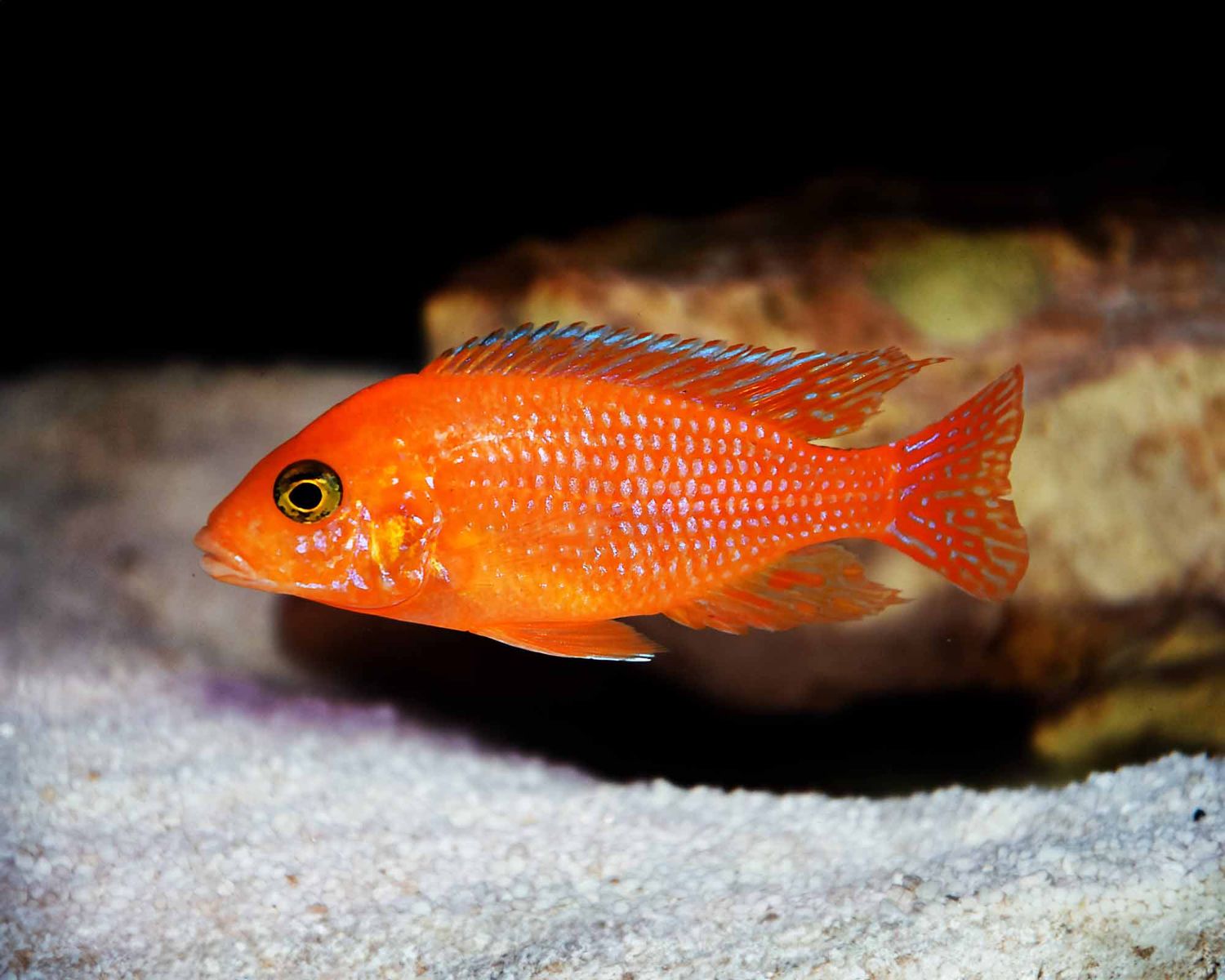Red Zebra Cichlid
The red zebra are native only to the reefs of Lake Malawi in Africa. While they are plentiful in their habitat, they are considered vulnerable because of their limited range. Males in wild species display a bright blue coloration with vertical black bars of varying degrees of intensity. Wild females display a deep orange or “red” coloration. However, captive-bred lines started showing off males with a bright orange coloration instead of blue. These males only display flecks or iridescent blue. Adding more to the confusion is that they are also one of the few species of Mbuna that can be mottled with black splotches on their body. They are usually labeled as OB in stores.
Mbuna is a Tonga word meaning “rockfish,” and like all mbuna species, red zebras can be found in the wild scouring large, rock reefs for algae and other small organisms. In captivity, they appreciate a tank that replicates their home environment. They like a lot of rocks in the aquarium to feel secure. They will dart in and out of the crevices, establish territories, and graze for algae if the tank is to their liking. Red zebras are also quite picky about water quality. Their native water has a very high oxygen and dissolved mineral content, and they need a high pH to thrive in the home aquarium. Adding an airstone or heavy circulation is recommended to keep the oxygen levels in the water high. There are also several commercial mixes available that replicate the water chemistry of the Africa Great Lakes. Adding rocks such as limestone to buffer and harden the water is also a good way to keep conditions favorable for them. Red zebras also need low levels of dissolved pollutants to remain healthy. Doing large, frequent water changes is necessary to keep red zebras happy and healthy. Otherwise, they can become susceptible to disease. Plants are most likely not a great idea as they will consume many of them, and most plants do not do well in the conditions these fish require. However, hardy plants such as Java fern, Java moss, and Anubias species can be kept successfully. Otherwise, use artificial plants to add some greenery to their tanks.
Red zebras, like most mbuna, need a high amount of green matter in their diet. Otherwise, they are very prone to developing Malawi bloat which is difficult to treat and often fatal. Feed red zebras with commercial algae wafers, blanched vegetables, or spirulina flakes to avoid any complications. The occasional meaty treat such as mysis shrimp can be given, but use a lot of caution when giving mbuna any meaty food.
Red zebras are one of the more peaceful mbunas, but it certainly does not mean they can be kept in peaceful community aquariums. They are aggressive and do best in large tanks with other mbuna species. They appreciate the company of their own kind, but rival males will kill each other if there isn’t enough room for their aggression to be spread around. Most people who keep mbunas successfully long term overstock their tanks to ensure the often intense aggression is spread out among a large number of individuals. Even then, fatalities due to fighting are not uncommon.
Red zebras are maternal mouthbrooders. If conditions are suitable, these fish will breed quite easily. Males and females can be slightly difficult to tell apart depending on the strain. Wild males will be blue in color, but many captive-bred specimens are orange just like the females. However, even the orange males can usually be distinguished by a lighter orange color and small flecks of iridescent blues, especially around their gill plates and head. Red zebras will be sexually mature at around 7.5cm. They can be conditioned by feeding more frequently, but it usually isn’t necessary to encourage a spawn. If you don’t see your fish breeding, it may be due to aggression in their tank, so you may need to create a more peaceful environment to encourage mating. The female will usually lay about twenty or thirty eggs on a flat surface in the male’s territory. She will then scoop up the eggs into her mouth and stimulate the male to fertilize the eggs in h

